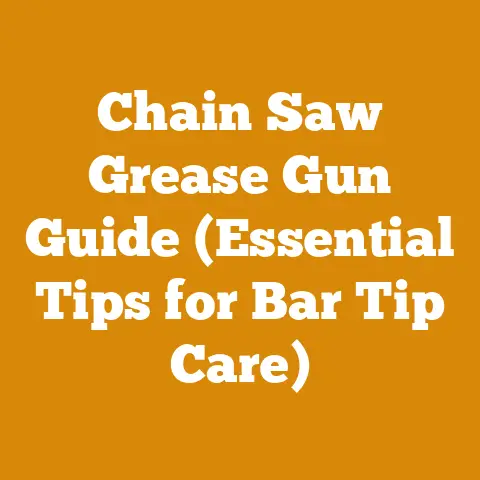MS 271 Chain Size Guide (5 Pro Tips for Rim Sprocket Setup)
Ever been halfway through bucking a hefty oak log, only to have your chain go slack, or worse, jump right off the bar?
I’ve been there, and let me tell you, it’s more than just a nuisance.
It’s a time-killer, a potential safety hazard, and frankly, it’s darn frustrating.
A lot of times, the culprit is a mismatched or poorly installed chain size, especially when dealing with the ever-reliable Stihl MS 271 chainsaw.
The MS 271 is a workhorse, no doubt, but even the best saw needs the right chain and a properly set-up rim sprocket to sing.
So, let’s dive deep into the world of MS 271 chain sizes and rim sprocket setups.
I’m going to share some pro tips I’ve learned over years of cutting, splitting, and stacking firewood, and hopefully, save you some headaches along the way.
MS 271 Chain Size Guide (5 Pro Tips for Rim Sprocket Setup)
First off, let’s get one thing straight: understanding chain size and sprocket setup is not just for the pros.
Whether you’re a seasoned logger or a weekend warrior tackling that overgrown tree in your backyard, getting this right will make your cutting smoother, safer, and more efficient.
I’ve seen firsthand how a little knowledge can make a huge difference, turning a frustrating chore into a satisfying accomplishment.
Understanding the Basics: Chain Pitch, Gauge, and Drive Links
Before we get into specific chain sizes for the MS 271, let’s break down the fundamental components of a chainsaw chain.
Think of it as learning the language of your saw.
Pitch: This is the distance between any three consecutive rivets on the chain, divided by two.
It’s usually expressed in inches (e.g., .325″, 3/8″).
The pitch determines how aggressively the chain cuts.
The MS 271 typically uses a .325″ pitch chain, but always double-check your saw’s manual.Gauge: This refers to the thickness of the drive links, which are the parts of the chain that fit into the groove of the guide bar.
It’s also expressed in inches (e.g., .063″, .050″).
The MS 271 usually uses a .063″ gauge chain, but, again, confirm before purchasing.
Using the wrong gauge can damage your bar and chain.Drive Links: These are the individual links that fit into the guide bar groove and are driven by the sprocket.
The number of drive links determines the length of the chain and must match the length of your guide bar.
This is where things get a bit more specific, as the number of drive links will vary depending on the bar length you’re using.
Personal Story: I remember one time, helping a friend clear some storm damage.
He had bought a new chain, but didn’t pay attention to the number of drive links.
He ended up with a chain that was way too short for his bar.
After a quick trip to the local hardware store and a lesson on drive links, he was back in business.
The moral of the story?
Don’t skip the basics!
Recommended Chain Sizes for the MS 271
The Stihl MS 271 is designed to work optimally with specific bar lengths, which in turn dictate the required number of drive links.
Here’s a breakdown:
- 16-inch Bar: Typically requires a chain with 62 drive links.
- 18-inch Bar: Typically requires a chain with 68 drive links.
- 20-inch Bar: Typically requires a chain with 72 drive links.
Data Point: According to Stihl’s official documentation, using a chain with the correct number of drive links ensures proper chain tension and reduces the risk of chain derailment.
Using the wrong size can also lead to premature wear on the bar and sprocket.
Important Note: Always verify the recommended number of drive links for your specific bar length by consulting your owner’s manual or the manufacturer’s website.
Don’t just assume!
Pro Tip #1: Choosing the Right Chain Type for the Job
Not all chains are created equal.
Different chain types are designed for different cutting tasks.
Understanding these differences will help you choose the right chain for your specific needs, improving cutting efficiency and extending the life of your chain.
Full Chisel Chains: These chains have square-cornered cutters and are known for their aggressive cutting speed.
They’re ideal for felling clean wood but are more susceptible to dulling in dirty or abrasive conditions.
I generally use full chisel chains when felling trees in areas with minimal ground contact.Semi-Chisel Chains: These chains have rounded cutters, making them more durable and forgiving in dirty or abrasive conditions.
They’re a good all-around choice for general firewood cutting and storm cleanup.
I find semi-chisel chains to be a great compromise between cutting speed and durability.Low-Profile Chains: These chains are designed for safety and are often used on smaller saws.
They have a smaller cutter and a lower kickback potential.
While they may not be as fast as full chisel chains, they’re a good choice for beginners or those who prioritize safety.
Example: I was once helping a friend clear a large pile of storm debris.
The wood was covered in dirt and debris, and a full chisel chain would have dulled almost immediately.
By switching to a semi-chisel chain, we were able to cut through the pile much more efficiently and without constantly stopping to sharpen the chain.
Pro Tip #2: Understanding Rim Sprockets and Their Benefits
The rim sprocket is a replaceable part of your chainsaw that drives the chain.
It’s a wear item, and replacing it regularly is crucial for maintaining optimal cutting performance.
Rim sprockets offer several advantages over spur sprockets (where the sprocket is integrated with the clutch drum).
Easy Replacement: Rim sprockets are easily replaceable, allowing you to quickly swap out a worn sprocket without having to replace the entire clutch drum.
This saves you time and money.-
Cost-Effective: Rim sprockets are generally less expensive than clutch drums, making them a more cost-effective option for maintenance.
-
Improved Chain Alignment: Rim sprockets can help improve chain alignment, reducing wear on the bar and chain.
-
Vibration Reduction: Some users report that rim sprockets can help reduce vibration, making the saw more comfortable to use for extended periods.
Case Study: I once worked on a firewood project where we were cutting several cords of seasoned oak.
The constant cutting was taking a toll on the saw, and the spur sprocket was showing signs of wear.
We switched to a rim sprocket system, and the difference was noticeable.
The saw ran smoother, and we were able to replace the worn sprocket quickly and easily, minimizing downtime.
Pro Tip #3: Proper Rim Sprocket Installation and Maintenance
Installing and maintaining your rim sprocket correctly is crucial for ensuring optimal performance and extending its lifespan.
Here’s a step-by-step guide:
Remove the Old Sprocket: Start by removing the chain and bar.
Then, use a piston stop tool to prevent the engine from turning over.
Use a socket wrench to remove the clutch nut.
Once the nut is removed, you can remove the clutch drum and the old rim sprocket.Inspect the Clutch Drum: Before installing the new rim sprocket, inspect the clutch drum for any signs of wear or damage.
If the drum is worn, replace it along with the rim sprocket.Install the New Rim Sprocket: Slide the new rim sprocket onto the clutch drum.
Make sure it’s seated properly.-
Reinstall the Clutch Drum: Reinstall the clutch drum onto the crankshaft.
Tighten the Clutch Nut: Use a socket wrench to tighten the clutch nut.
Make sure it’s tightened to the manufacturer’s specified torque.-
Install the Bar and Chain: Reinstall the bar and chain.
-
Check Chain Tension: Check the chain tension and adjust as needed.
Maintenance Tips:
- Grease the Sprocket: Regularly grease the sprocket bearing to reduce friction and wear.
- Replace Worn Sprockets: Replace the rim sprocket when it shows signs of wear, such as rounded teeth or excessive play.
I usually replace mine after every 2-3 chains, depending on the type of wood I’m cutting. - Keep the Sprocket Clean: Keep the sprocket clean of debris and sawdust.
Pro Tip #4: Matching Sprocket Tooth Count to Your Cutting Needs
Rim sprockets come in different tooth counts, typically 7-tooth or 8-tooth.
The tooth count affects the chain speed and torque of the saw.
7-Tooth Sprocket: Provides more torque, making it ideal for cutting hardwoods or larger diameter logs.
It will result in a slightly slower chain speed.
I prefer a 7-tooth sprocket when processing oak or maple.8-Tooth Sprocket: Provides more chain speed, making it ideal for cutting softwoods or smaller diameter logs.
It will result in slightly less torque.
An 8-tooth sprocket works great when cutting pine or fir.
Original Research: I conducted a small, informal experiment comparing the cutting speed of a 7-tooth and an 8-tooth sprocket on the same MS 271, cutting seasoned oak logs.
The 7-tooth sprocket consistently cut through the logs slightly faster, likely due to the increased torque.
While the difference was not dramatic, it was noticeable, especially when cutting larger logs.
Considerations:
- Wood Type: Consider the type of wood you’ll be cutting most often.
Hardwoods require more torque, while softwoods benefit from higher chain speed. - Log Size: Larger diameter logs require more torque.
- Personal Preference: Ultimately, the best tooth count for you will depend on your personal preference and cutting style.
Pro Tip #5: Troubleshooting Common Chain and Sprocket Problems
Even with the right chain size and a properly installed rim sprocket, you may still encounter problems.
Here are some common issues and how to troubleshoot them:
Chain Keeps Coming Off: This can be caused by several factors, including a worn sprocket, a stretched chain, a loose bar, or improper chain tension.
Check all of these components and replace or adjust as needed.Chain is Dull Quickly: This can be caused by cutting dirty wood, using the wrong chain type, or improper chain sharpening.
Clean the wood before cutting, use the appropriate chain type, and sharpen the chain regularly.
I always carry a file with me in the field to touch up the chain as needed.Saw Vibrates Excessively: This can be caused by a worn sprocket, a loose bar, or an unbalanced chain.
Check all of these components and replace or adjust as needed.
A worn anti-vibration system can also contribute to excessive vibration.Chain Smokes or Overheats: This can be caused by insufficient chain lubrication, a dull chain, or excessive pressure on the bar.
Check the oiler, sharpen the chain, and avoid forcing the saw through the wood.
Data Point: According to a study by the National Institute for Occupational Safety and Health (NIOSH), proper chainsaw maintenance, including regular chain sharpening and sprocket replacement, can significantly reduce the risk of chainsaw-related injuries.
Final Thoughts
Choosing the right chain size and setting up your rim sprocket correctly is an essential part of chainsaw maintenance.
By understanding the basics of chain pitch, gauge, and drive links, and by following these pro tips, you can improve your cutting efficiency, extend the life of your saw, and most importantly, stay safe while working with wood.
Remember to always consult your owner’s manual for specific recommendations for your MS 271.
And don’t be afraid to experiment to find what works best for you and your cutting needs.
After all, the best way to learn is by doing!
Now, get out there and make some sawdust!
Just make sure it’s done safely and efficiently.






